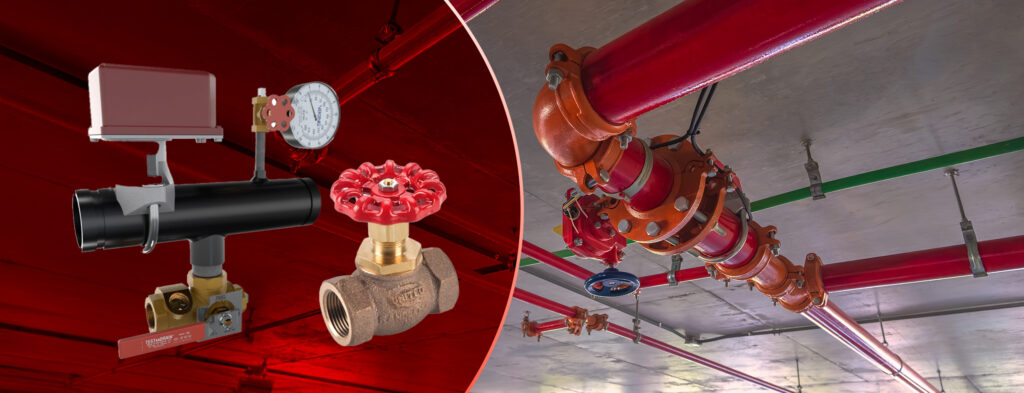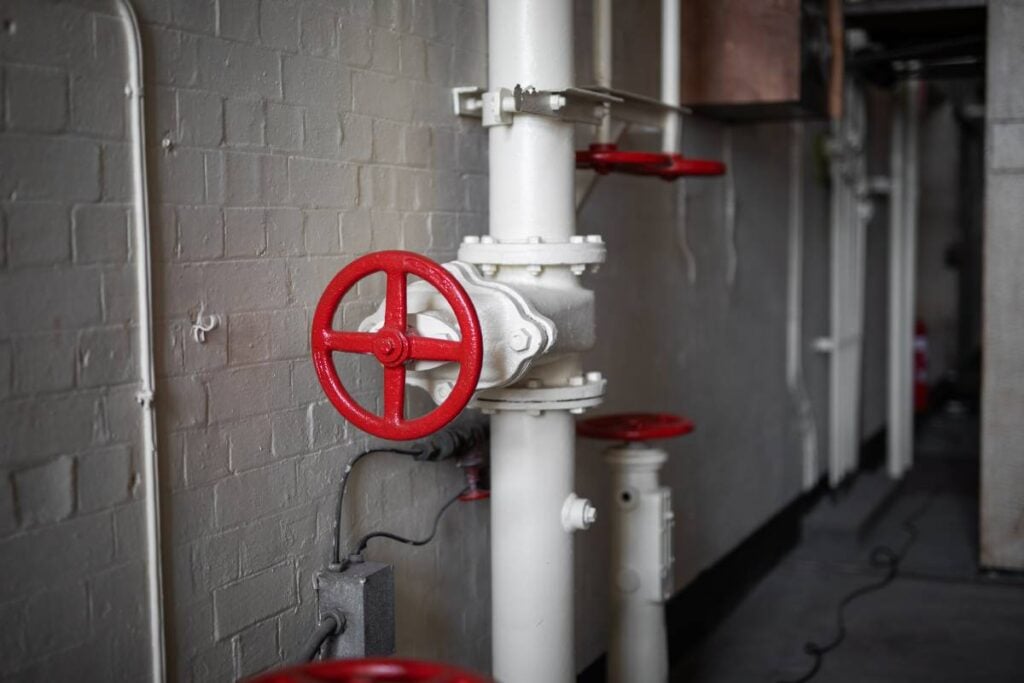
Often used in high-rises and multistory buildings, a floor control valve assembly (FCVA) is a piping assembly that controls the flow of water to and from a certain part of the building. In other words, it provides granular control over the sprinkler system of a specific portion of the building. Consequently, we can separate our overall sprinkler system into zones. This is often used to reduce water pressure going to lower floors, where higher pressure is needed for water to reach the top floors of a high-rise. Also, this enables us to shut off water for a portion of the building, allowing maintenance or construction activities. It may also mean that we can change the water pressure of a particular part of the building, or isolate a portion of the building if an activation occurs.
In some cases, a floor control valve assembly may be offered as a premade, out-of-the-box solution by the manufacturer. For example, Viking offers a ‘plug and play’ FCVA with the EasyPac series riser manifold assembly for high-rise buildings. In other cases, you can assemble your own FCVA using different parts that control water flow. The minimum parts required to construct your own assembly consists of a pressure gauge, check valve, control valve, main drain valve, and flow switch.
The NFPA 13 describes the national standard for sprinkler systems, and by extension, whether or not you will need a floor control valve assembly. Usually, FCVAs are required for sprinkler systems when your building exceeds two stories in height. Otherwise, you may also need to install a FCVA if you have a large area sprinkler system (greater than 5,000 sq. ft.) that requires its own control system. For instance, if you run a car rental or taxi service, you may have a large garage that needs its own floor control valve assembly. Due to the increase of plastics and battery powered vehicles, parking garages are classified as ordinary hazard group 2. The increased fire load means that the codes for sprinkler systems have become more stringent for this type of building. Therefore, having a FCVA will allow you to have more localized control and monitoring for your sprinkler system, especially in a more hazardous location.

Floor control valve assemblies are critical components that provide water to the sprinkler system when needed. For this reason, a bad control valve can compromise your entire sprinkler system and endanger the lives of any occupants. Besides the more apparent noises a control valve may make, there are many other ways to tell if your control valve has gone bad. Although there are different types of valves, a partially closed valve or closed valve should indicate a problem and trigger your supervisory alarm. Also, when a control valve has too much wear, it may start to leak, indicating worn down seals, gaskets, or a cracked valve body. Thus, it is important to regularly give your system a visual inspection for leaks, rust, or any physical damage. Furthermore, issues with your control valve may also result in abnormal pressure readings, including unusual pressure drops or fluctuations.
Other signs of a bad control valve may be stiffness or seizing of the hand-wheel or lever. Internal corrosion or physical damage may make it harder to fully open or close the control valve. Additionally, if you can turn the lever, but still can’t fully open or close the valve, this may also indicate physical wear on the system that would require a replacement. For these reasons, it is important to make sure that your control valves are exercised annually. Putting your control valve through its full range of motion may help prevent the valve from sticking, and it will help you to identify damage early, ensuring timely repairs. Making sure your FCVA works correctly is extremely important, since any damage can mean that your system may not get sufficient water flow during an emergency.
The NFPA 25 provides detailed requirements for the inspection and maintenance of fire sprinkler systems and floor control valve assemblies. Making weekly visual inspections of your fire alarm system is a good way to maintain safety.
To start, you should verify that your control valves are in the open position or supervised on a weekly basis. Also, check for external leakage or damage, which may not be supervised by your equipment. Other types of maintenance should be carried out by an expert or contractor on a regular basis according to the NFPA 25:
Ultimately, the NFPA 25 places responsibility for the proper inspection and maintenance of the sprinkler system on the property owner. Therefore, it is your responsibility to get your system inspected by someone that has experience on what to look out for. Typically, this means a Licensed Fire Suppression Contractor (LFSC) or a technician holding a Certificate of Fitness for Citywide Sprinkler Systems (S-12, S-13, etc.). An expert will be able to carry out more thorough tests, such as main drain tests, inspecting pre-action or deluge valves, testing antifreeze solution mixtures, hydrostatic tests and more.
During a fire sprinkler system inspection, nearly every part of your floor control valve assembly will be checked. They will inspect your control valves to ensure that they are open, accessible, and free from leaks. They will check pressure gauges for accuracy and that they are within specified limits, and they will look for leaks or signs of corrosion. Being proactive by regularly inspecting your system can go a long way when it comes to maintaining safety and compliance.
The Floor Control Valve Assembly is more than just hardware; it’s the heart of your building’s zoned fire safety. By providing precise, localized control and critical insights, proper FCVA installation and diligent maintenance are indispensable for safeguarding occupants and property, ensuring your sprinkler system stands ready when it matters most. If you are looking for your own sprinkler system installation, look no further than FireAlarm.com’s service center. We offer fire alarm system installations, suppression system design, and systems design services.
$1,181.00
$2,854.00
$5,011.00
$47.99
$114.49
$521.00
$1,447.00